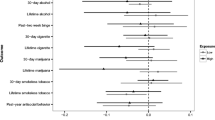Abstract
Despite the public health burden of adolescent substance use, delinquency, and other problem behavior, few comprehensive models of disseminating evidence-based prevention programs to communities have demonstrated positive youth outcomes at a population level, capacity to maintain program fidelity, and sustainability. We examined whether the Communities That Care (CTC; Hawkins and Catalano 1992) model had a positive impact on risk/protective factors and academic and behavioral outcomes among adolescents in a quasi-experimental effectiveness study. We conducted a longitudinal study of CTC in Pennsylvania utilizing biannual surveillance data collected through anonymous in-school student surveys. We utilized multilevel models to examine CTC impact on change in risk/protective factors, grades, delinquency, and substance use over time. Youth in CTC communities demonstrated less growth in delinquency, but not substance use, than youth in non-CTC communities. Levels of risk factors increased more slowly, and protective factors and academic performance decreased more slowly, among CTC community grade-cohorts that were exposed to evidence-based, universal prevention programs than comparison grade cohorts. Community coalitions can affect adolescent risk and protective behaviors at a population level when evidence-based programs are utilized. CTC represents an effective model for disseminating such programs.
Similar content being viewed by others
References
Arthur, M. W., Hawkins, J. D., Pollard, J. A., Catalano, R. F., & Baglioni, A. J., Jr. (2002). Measuring risk and protective factors for substance use, delinquency, and other adolescent problem behaviors: The Communities That Care youth survey. Evaluation Review, 26, 575–601.
Feinberg, M. E., Greenberg, M. T., Osgood, D. W., Anderson, A., & Babinski, L. (2002). The effects of training community leaders in prevention science: Communities That Care in Pennsylvania. Evaluation and Program Planning, 25, 245–259.
Feinberg, M. E., Greenberg, M. T., & Osgood, D. W. (2004a). Readiness, functioning, and perceived effectiveness of community prevention coalitions: A study of Communities That Care. American Journal of Community Psychology, 33, 163–176.
Feinberg, M. E., Greenberg, M. T., & Osgood, D. W. (2004b). Technical assistance in prevention programs: Correlates of perceived need in Communities That Care. Evaluation and Program Planning, 27, 263–274.
Feinberg, M. E., Greenberg, M. T., Osgood, D. W., Sartorius, J., & Bontempo, D. (2007a). Effects of the Communities That Care model in Pennsylvania on youth risk and problem behaviors. Prevention Science, 8, 261–270.
Feinberg, M.E., Ridenour, T.A., & Greenberg, M.T. (2007b). Aggregated indices of risk and protective factors in the Communities That Care survey. Journal of Adolescent Health, 40, 506–513 (June 2007).
Feinberg, M.E., Bontempo, D.E., & Greenberg, M.T. 2008. Predictors and level of sustainability of community prevention coalitions. American Journal of Preventive Medicine, 34, 495–501 (June 2008).
Glaser, R. R., Van Horn, M. L., Arthur, M. W., Hawkins, J. D., & Catalano, R. F. (2005). Measurement properties of the Communities That Care youth survey across demographic groups. Journal of Quantitative Criminology, 21, 73–102.
Hallfors, D., Hyunsan, C., Livert, D., & Kadushin, C. (2002). Fighting back against substance abuse: Are community coalitions winning? American Journal of Preventive Medicine, 23, 237–245.
Hawkins, J. D. & Catalano, R. F., Jr. (1992). Communities That Care: Action for drug abuse prevention. San Francisco: Jossey-Bass Inc.
Hawkins, J. D., Van Horn, M. L., & Arthur, M. W. (2004). Community variation in risk and protective factors and substance use outcomes. Prevention Science, 5, 213–220.
Hawkins, J.D., Brown, E.C., Oesterle, S., Arthur, M.W., Abbott, R.D., & Catalano, R. F. (2007). Early effects of Communities That Care on targeted risks and initiation of delinquent behavior and substance use. Journal of Adolescent Health, 43, 15–22 (June 2008).
Klerman, L. V., Santelli, J. S., & Klein, J. D. (2005). So what have we learned? The editors’ comments on the coalition approach to teen pregnancy. Journal of Adolescent Health, 37, S115–S118.
Roussos, S. T. & Fawcett, S. B. (2000). A review of collaborative partnerships as a strategy for improving community health. American Review of Public Health, 21, 369–402.
Shadish, W. R., Cook, T. D., & Campbell, D. T. (2002). Experimental and quasi-experimental designs for generalized causal inference. Boston: Houghton-Mifflin.
Spoth, R. L., Redmond, C., Shin, C., Greenberg, M. T., Clair, S., & Feinberg, M. E. (2007). Substance use outcomes at 18 months past baseline: The PROSPER community-university partnership trial. American Journal of Preventive Medicine, 32, 395–402.
Spoth, R. L., Greenberg, M. T., & Turrisi, R. (2008). Preventive interventions addressing underage drinking: State of the evidence and steps toward public health impact. Pediatrics, 121, S311–S336.
Woolf, S. H. (2008). The meaning of translation research and why it matters. Journal of American Medical Association, 299, 211–213.
Woolf, S. H. & Johnson, R. E. (2005). The break-even point: When medical advances are less important that improving the fidelity with which they are delivered. Annals of Family Medicine, 3, 545–552.
Acknowledgements
This research is supported by a grant from the Pennsylvania Commission for Crime and Delinquency (PCCD). However, findings and recommendations herein are those of the authors and not official statements of PCCD. We want to acknowledge the enthusiastic support of Michael Pennington, Ruth Williams, Douglas Hoffman, Raymond Moneta, and Clay R. Yeager at PCCD in supporting the vision of this project.
Author information
Authors and Affiliations
Corresponding author
Rights and permissions
About this article
Cite this article
Feinberg, M.E., Jones, D., Greenberg, M.T. et al. Effects of the Communities That Care Model in Pennsylvania on Change in Adolescent Risk and Problem Behaviors. Prev Sci 11, 163–171 (2010). https://doi.org/10.1007/s11121-009-0161-x
Published:
Issue Date:
DOI: https://doi.org/10.1007/s11121-009-0161-x




